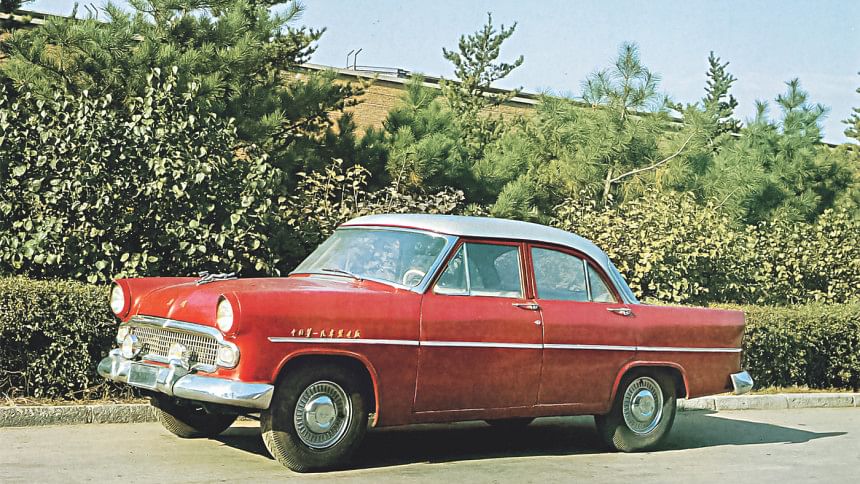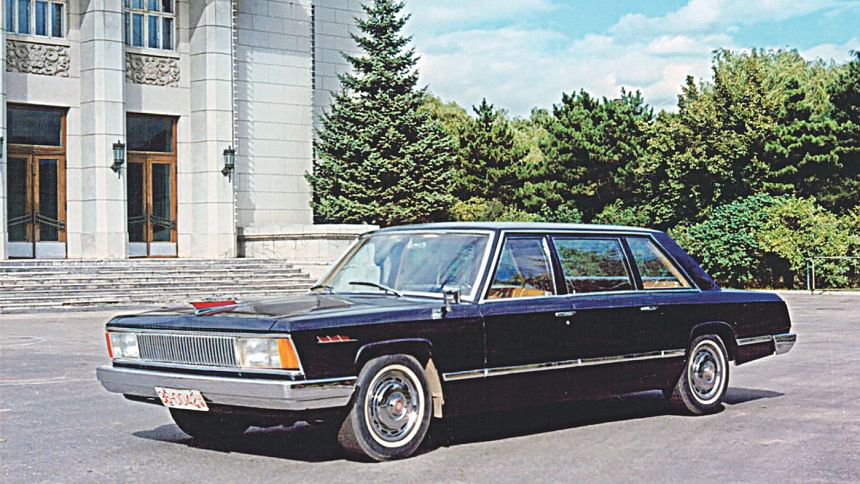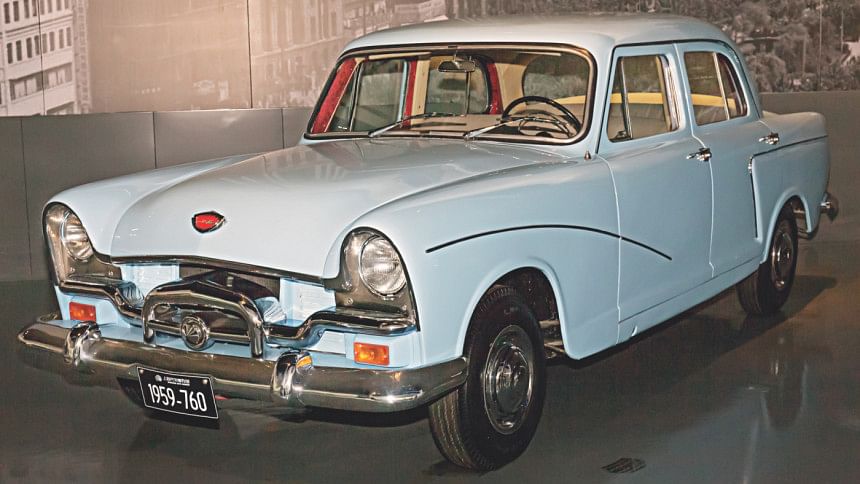70 years of Chinese automobiles

The early years and the first car of China: During the formative years of the PRC, the Chinese industry was still recovering from the carnage of World War II and the subsequent civil war. Most of the early "cars" made during this era were either re-bodied vehicles of foreign make, like the Chrysler Imperial based Hongqi (Red Flag) CA72 1E, or based heavily on foreign design, like the Soviet GAZ 21 Volga based 1966 Beijing Auto Dongfanghong (The East is Red) BJ760. There were attempts at making a fully indigenous car as well—one of the results was the First Auto Works (FAW) Dongfeng CA71, regarded by many as 'China's first car'. Built in 1958, the four door sedan was powered by a 1930cc Mercedes M121 based engine making around 70hp and was able to reach a top speed of 128 km/h. The production numbers for these car were very low, as China being a Communist State, personal ownership of cars was discouraged and production was more focused on industrial vehicles.

Cars during the Great Leap Forward (1958-1961): The PRC's desire to rapidly industrialise during the Great Leap Forward saw multiple car workshops putting together cars of their own designs. Lacking any outside help, most of them were based on contemporary Japanese or Western designs, with heavy styling inspiration from American cars. A few interesting examples of these efforts are the Tianjin Auto Repair Works Heping No. 1 and Tianjin University's Hongyuzhuan No. 1. Much like the Great Leap Forward itself, most of these were short lived with only a handful of prototypes being made. One exception to this was the Shanghai Auto Works' SH760 Fenghuang (Phoenix) sedan, of which over 3,000 were made for government use.
Cars during the Cultural Revolution (1966-1976): During the early days of the Cultural Revolution, Beijing ordered car manufactures to adopt a "no nonsense" design method. Cars had to have straight lines, sharp edge and no ornaments. Anything that would make a car look beautiful and desirable had to omitted, effectively making all cars impersonal "box on wheels". Hongqi, the government's state car manufacturer, responded to these requirements with the slab-sided CA774 series of prototypes while Shanghai Auto Works supplemented their SH760 sedan with the new, boxier looking SH763. Beijing Auto used this as an opportunity to phase out their now venerable BJ760, replacing it in 1967 with Dongfanghong BJ761 sedan and introducing a new model, the Hongwei (Red Guard) BJ761 station wagon.

Cars after the Cultural Revolution: The death of Mao Zedong in 1976 saw an end of the revolution and almost all the reforms that came with it. Car manufactures were quick to react, almost instantly moving out of the "no nonsense" car design doctrine. Hongqi immediately dropped the CA774 program, moving the 5 prototypes to storage and outright abandoning one at Beijing's Tsinghua University parking lot, where is still sits to this day. They instead introduced the CA750, a mid-size sedan that clearly took inspiration from Japan's Datsun 280C. Both Beijing and Shanghai Auto also wanted to replace their Revolution-era designs with new, Japanese-inspired ones, introducing the BJ750 and Shanghai's SH771 respectively. However, these cars were barred from production by the Chinese government, who saw no need for new cars. The Chinese car industry was thus forced to go back to building their older models and other vehicles, giving Shanghai Auto's SH760 Fenghuang (Phoenix) a new lease on life in the process.
Open market and the era of joint ventures (1980-2006): China's slow move away from Communist ideas after Mao's death led to opening their market and working with Western companies. For Chinese car manufacturers, this marked the start of the ability to freely sell cars to private buyers and the chance to enter into joint ventures with various foreign companies. Probably the most notable of the joint ventures that took place in this period was the FAW-Volkswagen deal that lasted from 1988 to 1999. This gave China access to the Audi 100 sedan, which went on to became the go-to platform for every local car maker in China for the next two decades. The versatile platform was modified to serve as parade cars, stretched limousines, police cars, pickup trucks and even a hearse. Partnership and badge engineering defines this era of the Chinese car industry, with very little actual local car development taking place.
Re-emergence of indigenous designs and purchase of foreign brands: Although most of the largest Chinese car makers were happy to partner with their foreign counterparts and pay the due expense, the smaller companies with less money at hand found their offerings being vastly outmatched by their joint venture counterparts. In response, they begun to outright copy or reverse engineer foreign designs without any royalties, using a loophole in the Chinese copyright law which ensured they will face no repercussion. There "knock-off" cars were far poorer in quality compared to the original counterpart and, in the long run, ended up badly damaging the image of Chinese brands in the international market. This was noticed by the big names of the Chinese car industry, who by the end of 2000's slowly begun developing their own designs and planning to sell their cars outside of the domestic market. In an effort to counter this and avoid any blunder, they began buying up struggling but well known Western brands and begun using their knowledge and expertise to develop cars specifically suited to Western market. Morris Garages/MG (now owned by SAIC Motor) of England and Volvo (now owned by Geely) of Sweden are notable examples.

Present day EV revolution: With air pollution reaching record levels, the Chinese government has mandated car makers make a gradual switch to "zero emissions vehicles". Local carmakers are already responding to this, with Hongqi introducing the E-HS3 Electric SUV. This call for electrification has led to a number of new Chinese car makers like NIO, which already received much praise in the international market.
Overall, the Chinese car industry has shared all the turmoil of its country but at the same time, advanced along with it. For all these hardship, their focus on EV puts them in the forefront of the next generation of car development and now has a strong chance to dominate the future of global car market.

 For all latest news, follow The Daily Star's Google News channel.
For all latest news, follow The Daily Star's Google News channel. 



Comments